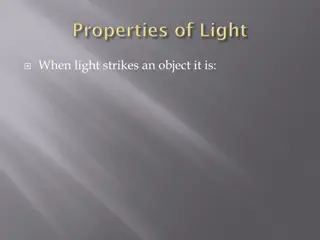Understanding Light: Key Concepts for Year 3 Students
Delve into the world of light with Year 3 students through engaging activities and explorations. Learn about sources of light, shadows, reflective surfaces, and the importance of light for vision. Discover how light helps us see and how shadows are formed, while exploring materials and objects that interact with light. Enhance your understanding of light through hands-on experiences and online resources recommended for teaching this captivating topic.
- Light exploration
- Year 3 curriculum
- Key learning objectives
- Student activities
- Educational resources
Download Presentation

Please find below an Image/Link to download the presentation.
The content on the website is provided AS IS for your information and personal use only. It may not be sold, licensed, or shared on other websites without obtaining consent from the author. Download presentation by click this link. If you encounter any issues during the download, it is possible that the publisher has removed the file from their server.
E N D
Presentation Transcript
Year 3: Light Year 3: Light This topic overview is based on the PLAN knowledge matrix (for England). Please use link: https://www.planassessment.c om/light-y3 The matrix includes: National Curriculum learning objectives Key learning Key vocabulary Common misconceptions Possible activities & evidence Topic overview for teachers Topic overview for teachers Age 7 Age 7- -8 8
Year 3 Light Topic Key Learning We see objects because our eyes can sense light. page Exploring that we need light to see things 4 Dark is the absence of light. We cannot see anything in complete darkness. Some surfaces reflect light. Exploring sources of light Some objects, for example, the Sun, a lit light bulb and a burning candle are sources of light. Objects are easier to see if there is more light. 5 Some surfaces reflect light. Exploring reflective surfaces 6 Objects are easier to see when there is less light if they are reflective. 2
Year 3 Light Topic Key Learning Shadows are formed on a surface when an opaque or translucent object is between a light source and the surface and blocks some of the light. page Identify opaque, translucent and transparent materials 7 Exploring materials and their properties to make sunglasses The light from the sun can damage our eyes and therefore we should not look directly at the sun. We can protect our eyes by wearing sunglasses or sunhats in bright light. 8 The size of the shadow depends on the position of the source, object and surface. Exploring how shadows are formed 9 3
Light Light Exploring that we need light to see things Logo for section to sit inside roundel Key Learning: Activities and websites Discussing prior knowledge about light. We see objects because our eyes can sense light. Dark is the absence of light. https://www.bbc.co.uk/bitesize/topics/zbssgk7/articl We cannot see anything in complete darkness. es/z2s4xfr Seeing in the dark. Some surfaces reflect light. https://www.bbc.co.uk/bitesize/clips/zb3s34j Exploring the need for light to see things. Finding out more about using lights in the dark. https://www.bbc.co.uk/bitesize/clips/zygvr82 I can recognise that you need light to see things. 4
Light Light Sources of light Sources of light Logo for section to sit inside roundel Activities and websites Explore light sources in a home. Key Learning Some objects, for example, the sun, a lit light bulb and a burning candle are sources of light. What is light? Objects are easier to see if there is more light. https://www.youtube.com/watch?v=1PsHHKwt XQU Sorting light sources and reflective objects. Which is the odd one out? https://explorify.wellcome.ac.uk/en/activities/o I can dd-one-out/sources-of-light identify which objects are sources of light and which reflect light. 5
Light Light Exploring reflective surfaces Logo for section to sit inside roundel Key Learning Activities and websites What do you already know about reflection? What is reflection? https://www.bbc.co.uk/bitesize/topics/zbssgk7/art icles/zqdxb82 Identifying how objects with different surfaces (e.g. shiny vs dull) are more or less visible. Finding out more about reflection. https://www.coolmathgames.com/0-rainbow- mechanic https://wowscience.co.uk/resource/light- absorption-reflection-refraction/ https://explorify.wellcome.ac.uk/en/activities/wha t-if/we-didnt-have-mirrors Some surfaces reflect light. Objects are easier to see when there is less light if they are reflective. I can identify how objects with different surfaces (e.g. shiny vs matt) are more or less visible. 6
Light Light Identify opaque, translucent and transparent materials Identify opaque, translucent and transparent materials Logo for section to sit inside roundel Key Learning Activities and websites What do you already know about properties of materials? Identifying opaque, translucent and transparent materials. https://www.dkfindout.com/uk/science/light/tr ansparent-and-opaque-objects/ Shadows are formed on a surface when an opaque or translucent object is between a light source and the surface and blocks some of the light. Finding and recording opaque, translucent and transparent materials around a home. Going further with translucent materials. I can identify materials that are opaque, translucent or transparent. 7
Light Light Exploring suitable materials for making sunglasses Exploring suitable materials for making sunglasses Logo for section to sit inside roundel Key Learning Activities and websites What do you already know about sunglasses? Finding out more about opaque, translucent and transparent materials. https://www.youtube.com/watch?v=18xY0XygV Gc https://www.dkfindout.com/uk/science/light/tr ansparent-and-opaque-objects/ The light from the sun can damage our eyes and therefore we should not look directly at the sun. We can protect our eyes by wearing sunglasses or sunhats in bright light. Exploring suitable materials for making sunglasses. I can explore suitable materials for making sunglasses. 8
Light Light Exploring how shadows are formed Logo for section to sit inside roundel Key Learning Activities and websites What do you already know about shadows? https://www.bbc.co.uk/bitesize/clips/z8vfb9q https://www.dkfindout.com/uk/science/light/sh adows/ Exploring shadows. https://explorify.wellcome.ac.uk/en/activities/w hats-going-on/shadow-shapes The size of the shadow depends on the position of the source, object and surface. Explaining how shadows are formed. I can explain how a shadow is formed. Going further with shadows (see lesson plan page 6 for websites). 9























